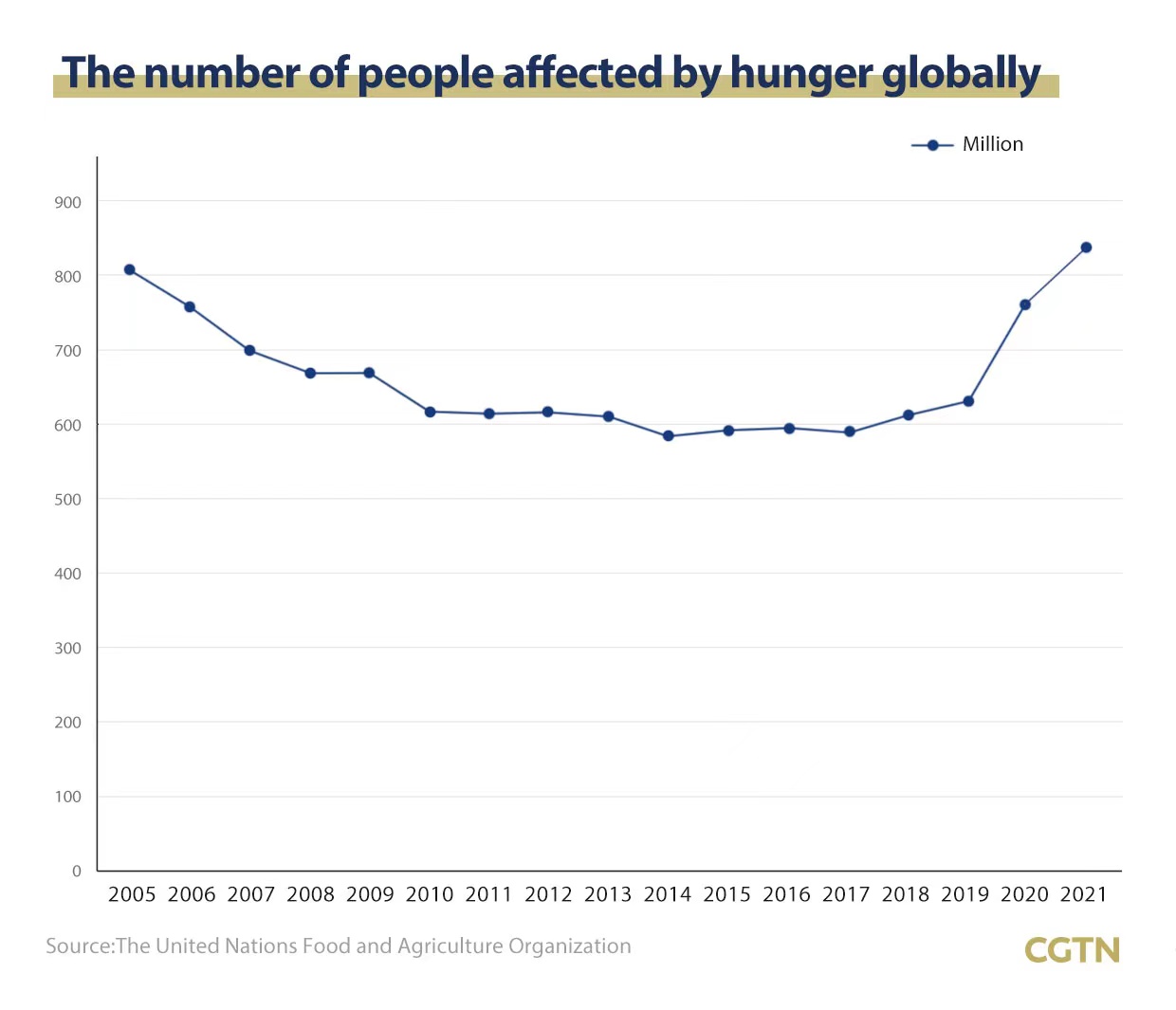The world is moving backward in its effort to eliminate hunger and malnutrition, said the United Nations in a recent report. The pandemic, turbulence in international relations and extreme weather events are threatening the world's food security.
According to the report, the number of people affected by hunger globally rose to as many as 828 million in 2021, about 10 percent of the world's population. Even with an improved global economy, nearly 670 million people will still be facing hunger in 2030, it projected.

Infographic of the number of people affected by hunger globally. /Designed by CGTN's Xing Cheng
Infographic of the number of people affected by hunger globally. /Designed by CGTN's Xing Cheng
October 16 is World Food Day, which is dedicated to ensuring food security and promoting global awareness and action for those suffering from hunger. This year's theme is "Leave no one behind."
"Food security" means that all people, at all times, have physical, social and economic access to sufficient, safe and nutritious food that meets their food preferences and dietary needs for an active and healthy life.
Grain, as a dominant part of all the food sources essential to our energy and nutrition needs, accounts for 25 percent of the total daily food requirement and plays an important role in food security.
Food security has always been a major concern in China. Compared with 1978, when China first adopted its "reform and opening-up" policy, the population has increased by almost 50 percent and the amount of grain that each person can access has also grown by 50 percent. Starting in 2015, China's grain output remained above 650 million tonnes for seven consecutive years, and reached a new high of 682.85 million tonnes in 2021, according to National Bureau of Statistics. The country's rice and wheat reserves also remain high enough to sustain the entire population for more than a year.

Infographic of China's grain production between 2005 to 2021. /Designed by CGTN's Xing Cheng
Infographic of China's grain production between 2005 to 2021. /Designed by CGTN's Xing Cheng
However, China, as the world's largest grain producer and third-largest grain exporter, is also the largest grain importer. China imports huge amounts of soybeans, corn and crop seeds. To better ensure its food security, China is trying to protect its arable land, expand key crop planting, promote agricultural mechanization and invest in seed research and development.
Feeding its people has always been China's top priority. At the same time, China is committed to helping build a world free of hunger.
China has continuously deepened international cooperation on food supply. It has supported the World Food Program in setting up a global humanitarian response depot and hub in China and established and sponsored the China-FAO (UN's Food and Agriculture Organization) South-South Cooperation Trust Fund.
Together with the FAO, China has launched 25 projects in developing countries that have driven up crop yields by 30 to 60 percent in the project areas, benefiting more than 1.5 million small-scale farmers worldwide. Also, China has promoted more than 1,000 agricultural technologies globally and has conducted agricultural exchanges with over 140 countries and regions. More than 1,000 Chinese experts are in the fields of different countries, helping local farmers generate better lives, according to China's Ministry of Agriculture and Rural Affairs.
Meanwhile, Chinese hybrid rice is growing on 8 million hectares spread over more than 60 countries, with an average yearly yield that is 2 tonnes higher per hectare than that of local rice. So far this year, China has provided more than 30,000 tonnes of emergency humanitarian food aid to developing countries in need, according to China's Ministry of Foreign Affairs.

Map of China's hybrid rice grown in other countries. /Designed by CGTN's Xing Cheng
Map of China's hybrid rice grown in other countries. /Designed by CGTN's Xing Cheng
China hopes to contribute its share to global food security by strengthening international communication and cooperation.
Only by working together can countries, governments, businesses and individuals ensure that no one is left behind.
(Cover image designed by CGTN's Li Wenyi and Li Jingjie.)
(If you want to contribute and have specific expertise, please contact us at nature@cgtn.com.)